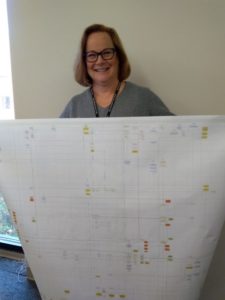Each year during the Department of State’s Annual Close season, MIL members team with their government counterparts to connect over 31 processes, multiple financial systems, and hundreds of people to ensure a successful balancing of the government’s fiscal books. Before 2019, each department operated independently on their own processes with minimal insight to the impact on other department’s  systems. Efforts were continuously underway to connect teams and provide transparency to how all the systems were interconnected. In January 2019, the Allotment Accounting department developed a Continuous Improvement Action Plan (CAP) to expand key stakeholder knowledge and awareness of the Annual Close Budget and Cash related dates, activities performed during fiscal year end Close (which usually begins in July and finishes by October of each year), and resources required to perform the activities. The need existed for a comprehensive and collaborative big picture of all the interdependencies and business processes within all GFO offices.
systems. Efforts were continuously underway to connect teams and provide transparency to how all the systems were interconnected. In January 2019, the Allotment Accounting department developed a Continuous Improvement Action Plan (CAP) to expand key stakeholder knowledge and awareness of the Annual Close Budget and Cash related dates, activities performed during fiscal year end Close (which usually begins in July and finishes by October of each year), and resources required to perform the activities. The need existed for a comprehensive and collaborative big picture of all the interdependencies and business processes within all GFO offices.
That’s when MIL’s Joan Cugell, a Senior Manager on the Systems, Coordination, and Implementation (SCI) Team stepped in to guide the entire process. She and her team developed a comprehensive process flow map to capture and document each of the 31 processes. Her ability to gather all aspects of the complex process led to a gigantic process flow map which measured 4 feet by 4 feet and captured the entire Department of State financial Annual Close process. The process flow demonstrates exactly how all these processes tie into one system in order to balance the Department’s financial accounts.
However, it isn’t so much the final product which provides the most benefit. According to Joan, the collaboration to build and feed such a process map required so many people from all departments—and that collaboration created deeper understanding on everyone’s parts about how the smallest tasks can have a trickledown effect which leads to later challenges. The process of capturing the cause and effect of each department’s roles eliminated duplicate efforts, non-value-added efforts, and process wastes. The communication during this effort also helped identify time-sensitive interdependencies and addressed areas to improve communication throughout the organization.
Joan mentioned she was surprised to see the sheer number of people, departments, and systems involved and the complexity of how all the cross-dependencies needed to flow for a successful and on-time Annual Close. The process map is being shared with the Comptroller of the Global Financial Services (CGFS) and external auditors with the intention of implementing a yearly review prior to Annual Close—by doing so, the map remains a living document serving a culture of continuous improvement.
